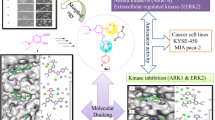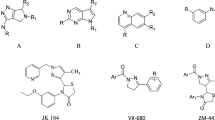Abstract
Combinatorial library based on a biologically relevant core template, 2-aminothiazole, with immense scope of diversity multiplication was designed for anticancer therapeutics. The diversity elements were incorporated through azomethine linkage on C4 hydrazine terminus in 5-benzoyl-2-arylamino-1,3-thiazole using isopropyl, isobutyl, cyclohexyl, and benzyl fragments and enrichment of chemical space therein was evaluated. Molecular docking of an in-house 200-member virtual library in anticancer target proteins- estrogen receptor (3ERT), cyclin dependent kinase (3FDN), and Aurora kinase (3LAU), identified selective binding of the compounds as ATP competitive inhibitors of 3LAU. The synthetic access to the compounds was realized through a facile and economically viable [4 + 1] ring synthesis strategy employing commercially available reagents. The in vitro cytotoxicity of selected members against human cancer cell lines indicated the potential of the designed scaffold in anticancer drug discovery, where compounds 2b, 3b, and 4b were found to be active against MCF-7 and A549 cell lines in less than ten micro molar concentrations. Moreover the predicted physicochemical properties pointed to the drug appropriateness for most of these molecules, that they obey the rule of five (RO5). Thus we present 2-alkyl/arylamino-4-alkylidene/arylidenehydrazino-5-benzoyl-1,3-thiazoles as a prospective and expandable skeleton for diversity oriented synthesis and in the discovery of selective Aurora kinase inhibitors.










Similar content being viewed by others
References
Altıntop MD, Özdemir A, Turan-Zitouni G, Ilgın S, Atlı Ö, Demirci F, Kaplancıklı ZA (2014) Synthesis and in vitro evaluation of new nitro-substituted thiazolyl hydrazone derivatives as anticandidal and anticancer agents. Molecules 19:14809–14820
Ayati A, Emami S, Asadipour A, Shafiee A, Foroumadi A (2015) Recent applications of 1, 3-thiazole core structure in the identification of new lead compounds and drug discovery. Eur JMed Chem 97:699–718
Bennani YL (2012) Drug discovery in the next decade: innovation needed ASAP. Drug Discov Today 17:S31–S44
Bharti SK, Nath G, Tilak R, Singh S (2010) Synthesis, anti-bacterial and anti-fungal activities of some novel Schiff bases containing 2, 4-disubstituted thiazole ring. Eur J Med Chem 45:651–660
Carpinelli P, Ceruti R, Giorgini ML, Cappella P, Gianellini L, Croci V, Degrassi A, Texido G, Rocchetti M, Vianello P (2007) PHA-739358, a potent inhibitor of Aurora kinases with a selective target inhibition profile relevant to cancer. Mol Cancer Ther 6:3158–3168
Carradori S, Secci D, Bolasco A, Rivanera D, Mari E, Zicari A, Lotti LV, Bizzarri B (2013) Synthesis and cytotoxicity of novel (thiazol-2-yl) hydrazine derivatives as promising anti-Candida agents. Eur J Med Chem 65:102–111
Chen G, Zheng S, Luo X, Shen J, Zhu W, Liu H, Gui C, Zhang J, Zheng M, Puah CM (2005) Focused combinatorial library design based on structural diversity, druglikeness and binding affinity score. J Comb Chem 7:398–406
Cheng Y, Avula SR, Gao W-W, Addla D, Tangadanchu VKR, Zhang L, Lin J-M, Zhou C-H (2016) Multi-targeting exploration of new 2-aminothiazolyl quinolones: synthesis, antimicrobial evaluation, interaction with DNA, combination with topoisomerase IV and penetrability into cells. Eur J Med Chem 124:935–945
Dandawate P, Ahmad A, Deshpande J, Swamy KV, Khan EM, Khetmalas M, Padhye S, Sarkar F (2014) Anticancer phytochemical analogs 37: synthesis, characterization, molecular docking and cytotoxicity of novel plumbagin hydrazones against breast cancer cells. Bioorg Med Chem Lett 24:2900–2904
Das D, Sikdar P, Bairagi M (2016) Recent developments of 2-aminothiazoles in medicinal chemistry. Eur J Med Chem 109:89–98
Deng Z-L, Du C-X, Li X, Hu B, Kuang Z-K, Wang R, Feng S-Y, Zhang H-Y, Kong D-X (2013) Exploring the biologically relevant chemical space for drug discovery. J Chem Inf Model 53:2820–2828
Dilek Altıntop M, Cantürk Z, Baysal M, Asım Kaplancıklı Z (2016) Synthesis and evaluation of new thiazole derivatives as potential antimicrobial agents. Lett Drug Des Discov 13:903–911
Dilek Altıntop M, Ozdemir A, Ilgın S, Atli O (2014) Synthesis and biological evaluation of new pyrazole-based thiazolyl hydrazone derivatives as potential anticancer agents. Lett Drug Des Discov 11:833–839
Dimova D, Bajorath J (2016) Systematic design of analogs of active compounds covering more than 1000 targets. MedChemComm 7:859–863
Dobson CM (2004) Chemical space and biology. Nature 432:824–828
Dua R, Shrivastava S, Sonwane S, Srivastava S (2011) Pharmacological significance of synthetic heterocycles scaffold: a review. Adv Biol Res 5:120–144
Fancelli D, Moll J, Varasi M, Bravo R, Artico R, Berta D, Bindi S, Cameron A, Candiani I, Cappella P (2006) 1, 4, 5, 6-tetrahydropyrrolo [3, 4-c] pyrazoles: identification of a potent Aurora kinase inhibitor with a favorable antitumor kinase inhibition profile. J Med Chem 49:7247–7251
Friesner RA, Murphy RB, Repasky MP, Frye LL, Greenwood JR, Halgren TA, Sanschagrin PC, Mainz DT (2006) Extra precision glide: docking and scoring incorporating a model of hydrophobic enclosure for protein-ligand complexes. J Med Chem 49:6177–6196
Gallardo-Godoy A, Gever J, Fife KL, Silber BM, Prusiner SB, Renslo AR (2011) 2-Aminothiazoles as therapeutic leads for prion diseases. J Med Chem 54:1010–1021
Gorczynski MJ, Leal RM, Mooberry SL, Bushweller JH, Brown ML (2004) Synthesis and evaluation of substituted 4-aryloxy-and 4-arylsulfanyl-phenyl-2-aminothiazoles as inhibitors of human breast cancer cell proliferation. Bioorg Med Chem 12:1029–1036
Gorse A-D (2006) Diversity in medicinal chemistry space. Curr Top Med Chem 6:3–18
Green DA, Antholine WE, Wong SJ, Richardson DR, Chitambar CR (2001) Inhibition of malignant cell growth by 311, a Novel Iron chelator of the pyridoxal isonicotinoyl hydrazone class effect on the R2 subunit of ribonucleotide reductase. Clin Cancer Res 7:3574–3579
Hajduk PJ, Galloway WR, Spring DR (2011) Drug discovery: a question of library design. Nature 470:42–43
Holla BS, Malini K, Rao BS, Sarojini B, Kumari NS (2003) Synthesis of some new 2, 4-disubstituted thiazoles as possible antibacterial and anti-inflammatory agents. Eur J Med Chem 38:313–318
John Harris C, Hill RD, Sheppard DW, Slater MJ, Stouten PFW (2011) The design and application of target-focused compound libraries. Comb Chem High Throughput Screen 14:521–531
Jorgensen WL, Maxwell DS, Tirado-Rives J (1996) Development and testing of the OPLS All-Atom force field on conformational energetics and properties of organic liquids. J Am Chem Soc 118:11225–11236
Kalinowski DS, Sharpe PC, Bernhardt PV, Richardson DR (2007) Design, synthesis, and characterization of new iron chelators with anti-proliferative activity: structure-activity relationships of novel thiohydrazone analogs. J Med Chem 50:6212–6225
Kaplánek R, Havlík M, Dolenský B, Rak J, Džubák P, Konečný P, Hajdúch M, Králová J, Král V (2015a) Synthesis and biological activity evaluation of hydrazone derivatives based on a Tröger’s base skeleton. Bioorg Med Chem 23:1651–1659
Kaplánek R, Jakubek M, Rak J, Kejík Z, Havlík M, Dolenský B, Frydrych I, Hajdúch M, Kolář M, Bogdanová K (2015b) Caffeine–hydrazones as anticancer agents with pronounced selectivity toward T-lymphoblastic leukemia cells. Bioorg Chem 60:19–29
Kashyap SJ, Garg VK, Sharma PK, Kumar N, Dudhe R, Gupta JK (2012) Thiazoles: having diverse biological activities. Med Chem Res 21:2123–2132
Lipinski C, Hopkins A (2004) Navigating chemical space for biology and medicine. Nature 432:855–861
Lovejoy DB, Richardson DR (2002) Novel “hybrid” iron chelators derived from aroylhydrazones and thiosemicarbazones demonstrate selective antiproliferative activity against tumor cells. Blood 100:666–676
Manfredi MG, Ecsedy JA, Meetze KA, Balani SK, Burenkova O, Chen W, Galvin KM, Hoar KM, Huck JJ, LeRoy PJ (2007) Antitumor activity of MLN8054, an orally active small-molecule inhibitor of Aurora A kinase. Proc Natl Acad Sci 104:4106–4111
Mortlock AA, Foote KM, Heron NM, Jung FH, Pasquet G, Lohmann J-JM, Warin N, Renaud F, De Savi C, Roberts NJ (2007) Discovery, synthesis, and in vivo activity of a new class of pyrazoloquinazolines as selective inhibitors of aurora B kinase. J Med Chem 50:2213–2224
Nasr T, Bondock S, Youns M (2014) Anticancer activity of new coumarin substituted hydrazide–hydrazone derivatives. Eur J Med Chem 76:539–548
Novinson T, Bhooshan B, Okabe T, Revankar GR, Robins RK, Senga K, Wilson HR (1976) Novel heterocyclic nitrofurfural hydrazones. In vivo antitrypanosomal activity. J Med Chem 19:512–516
Paula SSP, Yardilyb A, Rajasekharanc K, Reji TAF (2013) Synthesis of anticancer compounds 2-(4-amino-2-arylaminothiazol-5-oyl)-N-methylbenzimidazoles. Indian J Chem 52:560–564
Prien O (2005) Target‐family‐oriented focused libraries for kinases—conceptual design aspects and commercial availability. ChemBioChem 6:500–505
Rodrigues T, Reker D, Welin M, Caldera M, Brunner C, Gabernet G, Schneider P, Walse B, Schneider G (2015) De Novo fragment design for drug discovery and chemical biology. Angew Chem Int Ed 54:15079–15083
Rollas S, Küçükgüzel SG (2007) Biological activities of hydrazone derivatives. Molecules 12:1910–1939
Romagnoli R, Baraldi PG, Carrion MD, Cruz-Lopez O, Lopez Cara C, Basso G, Viola G, Khedr M, Balzarini J, Mahboobi S (2009) 2-Arylamino-4-amino-5-aroylthiazoles.“One-pot” synthesis and biological evaluation of a new class of inhibitors of tubulin polymerization. J Med Chem 52:5551–5555
Savini L, Chiasserini L, Travagli V, Pellerano C, Novellino E, Cosentino S, Pisano MB (2004) New α-(N)-heterocyclichydrazones: evaluation of anticancer, anti-HIV and antimicrobial activity. Eur J Med Chem 39:113–122
Schneider G, Fechner U (2005) Computer-based de novo design of drug-like molecules. Nat Rev Drug Discov 4:649–663
Schneider G, Schneider P (2016) Coping with complexity in ligand-based de novo design. Frontiers in molecular design and chemical information Science-Herman Skolnik Award Symposium 2015: Jürgen Bajorath. ACS Publications
Schrödinger (2014) Maestro, version 9.6. LLC, New York, NY
Secci D, Bizzarri B, Bolasco A, Carradori S, D’Ascenzio M, Rivanera D, Mari E, Polletta L, Zicari A (2012) Synthesis, anti-Candida activity, and cytotoxicity of new (4-(4-iodophenyl) thiazol-2-yl) hydrazine derivatives. Eur J Med Chem 53:246–253
Sengupta S, Smitha SL, Thomas NE, Santhoshkumar TR, Devi SK, Sreejalekshmi KG, Rajasekharan KN (2005) 4‐Amino‐5‐benzoyl‐2‐(4‐methoxyphenylamino) thiazole (DAT1): a cytotoxic agent towards cancer cells and a probe for tubulin‐microtubule system. Br J Pharmacol 145:1076–1083
Sheppard DW, MacRitchie JA (2013) Building in molecular diversity for targeted libraries. Drug Discov Today 10:e461–e466
Skehan P, Storeng R, Scudiero D, Monks A, McMahon J, Vistica D, Warren JT, Bokesch H, Kenney S, Boyd MR (1990) New colorimetric cytotoxicity assay for anticancer-drug screening. J Natl Cancer Inst 82:1107–1112
Song Y, Chen W, Kang D, Zhang Q, Zhan P, Liu X (2014) “Old friends in new guise”: exploiting privileged structures for scaffold re-evolution/refining. Comb Chem High Throughput Screen 17:536–553
Sreejalekshmi K (2010) A facile, sequential multicomponent approach to N-aminoamidinothioureas—versatile synthons to bioactive heterocycles. Phosphorus Sulfur Silicon 185:1830–1837
Tian F-F, Jiang F-L, Han X-L, Xiang C, Ge Y-S, Li J-H, Zhang Y, Li R, Ding X-L, Liu Y (2010) Synthesis of a novel hydrazone derivative and biophysical studies of its interactions with bovine serum albumin by spectroscopic, electrochemical, and molecular docking methods. J Phys Chem B114:14842–14853
Titus S, Sreejalekshmi KG (2014) One-pot four-component synthesis of 4-hydrazinothiazoles: novel scaffolds for drug discovery. Tetrahedron Lett 55:5465–5467
Urich R, Wishart G, Kiczun M, Richters A, Tidten-Luksch N, Rauh D, Sherborne B, Wyatt PG, Brenk R (2013) De novo design of protein kinase inhibitors by in silico identification of hinge region-binding fragments. ACS Chem Biol 8:1044–1052
Verma G, Marella A, Shaquiquzzaman M, Akhtar M, Ali MR, Alam MM (2014) A review exploring biological activities of hydrazones. J Pharm Bioallied Sci 6:69
Vichai V, Kirtikara K (2006) Sulforhodamine B colorimetric assay for cytotoxicity screening. Nat Protoc 1:1112–1116
Welsch ME, Snyder SA, Stockwell BR (2010) Privileged scaffolds for library design and drug discovery. Curr Opin Chem Biol 14:347–361
Wilkinson RW, Odedra R, Heaton SP, Wedge SR, Keen NJ, Crafter C, Foster JR, Brady MC, Bigley A, Brown E (2007) AZD1152, a selective inhibitor of Aurora B kinase, inhibits human tumor xenograft growth by inducing apoptosis. Clin Cancer Res 13:3682–3688
Yan A, Wang L, Xu S, Xu J (2011) Aurora-A kinase inhibitor scaffolds and binding modes. Drug Discov Today 16:260–269
Yu X, Shi L, Ke S (2015) Acylhydrazone derivatives as potential anticancer agents: synthesis, bio-evaluation and mechanism of action. Bioorg Med Chem Lett 25:5772–5776
Yurttaş L, Özkay Y, Kaplancıklı ZA, Tunalı Y, Karaca H (2013) Synthesis and antimicrobial activity of some new hydrazone-bridged thiazole-pyrrole derivatives. J Enzyme Inhib Med Chem 28:830–835
Acknowledgements
ST acknowledges IIST for financial support. Thanks are due to NIIST-TVM, IISER-TVM for support in NMR recording and ACTREC Mumbai for in vitro anticancer screening.
Author information
Authors and Affiliations
Corresponding author
Ethics declarations
Conflict of interest
The authors declare that they have no competing interests.
Electronic supplementary material
Rights and permissions
About this article
Cite this article
Titus, S., Sreejalekshmi, K.G. Enriching biologically relevant chemical space around 2-aminothiazole template for anticancer drug development. Med Chem Res 27, 23–36 (2018). https://doi.org/10.1007/s00044-017-2039-y
Received:
Accepted:
Published:
Issue Date:
DOI: https://doi.org/10.1007/s00044-017-2039-y




